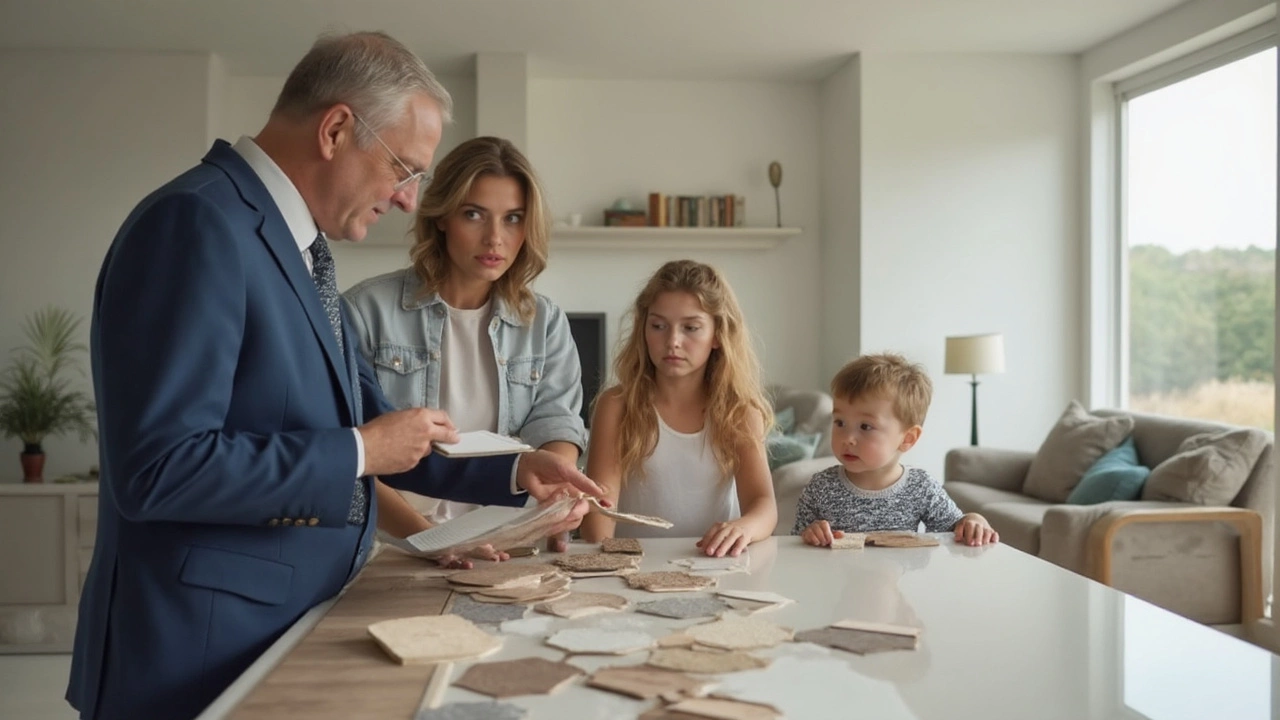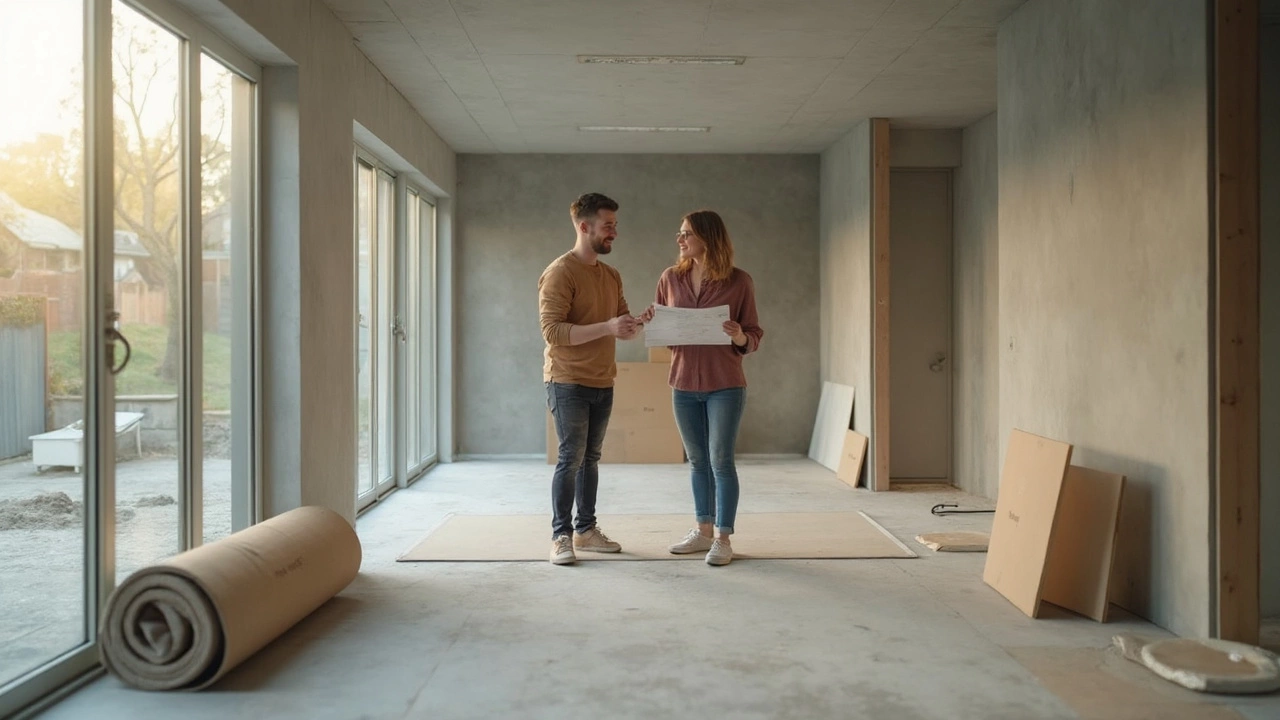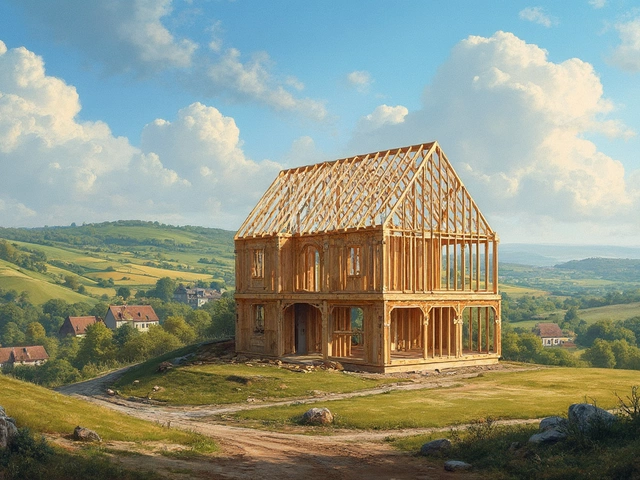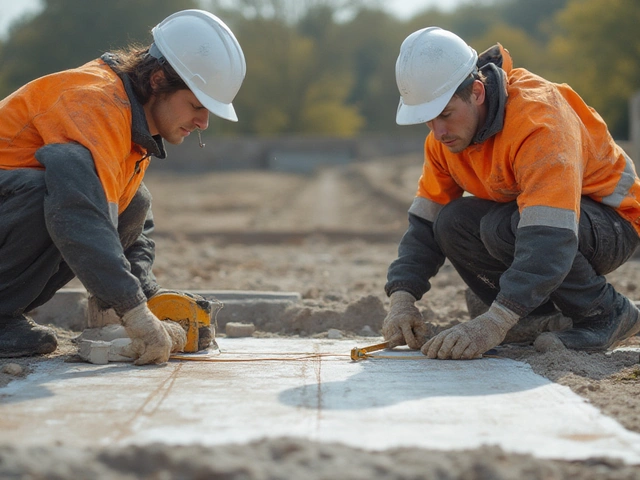So, you’re eyeing that shiny new home, picturing life in a spotless, fresh space. But here’s something that catches a lot of buyers off guard: new builds often don’t come with the flooring you’d expect. Think bare concrete or subfloor in rooms you assumed would be move-in ready. Sounds odd, right? But it’s surprisingly common—especially if you’re shopping in the UK or certain U.S. areas.
Builders usually include the absolute basics: painted walls, plumbing, electrical, and maybe kitchen cabinets. Flooring is often “optional,” and what you see in the model home isn’t always what you’ll get. Sometimes you might get cheap builder-grade carpet in bedrooms, and that’s it. Some don’t even give you that. It really depends on the developer, and the fine print in your contract.
Before you sign anything, look for the phrase 'floor coverings included.' If it’s missing, ask! The last thing you want is moving in only to realize you need to fork out thousands more for flooring installers, or live on bare plywood until you sort it out.
- What’s Actually Included in a New Build?
- Typical Flooring Options (and What Gets Left Out)
- Upgrades, Costs, and Common Pitfalls
- Tips to Get the Best Flooring Deal
What’s Actually Included in a New Build?
The term “new build” can make you think everything’s set for you to just move your stuff in and kick back. Not so fast. What’s included in a new build home depends a lot on the developer, location, and price bracket. In most cases, you get the absolute basics. That means the foundation, walls with a basic paint job, plumbing, and working electrics are all good to go. Kitchens usually come with fitted cabinets and countertops, while bathrooms will have the main fixtures in place. But the “finishes”—which definitely includes flooring—are a different story.
Here’s what you’ll usually get as standard in a new build:
- Walls painted in one neutral color, no fancy trims or feature walls.
- Basic bathroom suites: toilet, basin, and shower or bathtub installed.
- Kitchen units and worktops, but often no appliances beyond the oven and hob.
- Lights and sockets installed, but usually builder-grade fixtures.
- Heating system (radiators or central air) is working from day one.
- Windows and external doors fitted with basic locks.
Now, when it comes to flooring in a new build, things get sketchy. The majority of developers will give you:
- Basic tiles or vinyl in bathrooms and possibly the kitchen.
- Carpet in bedrooms or sometimes just the stairs—usually the cheapest available.
- No real wood, luxury vinyl, or stylish tile without paying extra.
- Living rooms, hallways, and pretty much everywhere else? Sometimes just a bare subfloor.
This table gives you a quick idea of what’s typical in a UK or US new build:
| Room | Included Flooring | Common Upgrades |
|---|---|---|
| Kitchen | Basic vinyl or tile | Ceramic tile, engineered wood |
| Bathroom | Vinyl or tile | Porcelain tile, waterproof laminate |
| Bedroom | Cheap carpet (sometimes none) | Premium carpet, wood, laminate |
| Living Room | Usually bare (sometimes carpet) | Wood, laminate, higher-end carpet |
Before you get wowed by the model home, find out exactly what’s in your contract. Some builders run “sales events” where an upgraded flooring package is thrown in—but don’t count on it. Always check, ask outright, and get every finish listed in writing. If you see nice solid wood floors at the show house, there’s a high chance they cost extra, and you won’t get them in your standard price.
Typical Flooring Options (and What Gets Left Out)
If you think buying a new build means you automatically get shiny hardwood floors or plush carpet in every room, that’s hardly ever the case. Developers usually offer a few basic types of flooring included—and sometimes, just barely.
In most entry-level or mid-range new builds, you’ll probably see:
- Low-cost carpet in bedrooms (often called “builder’s grade” carpet—think basic beige, not luxury upgrade)
- Sheet vinyl or basic laminate for hallways, living rooms, and kitchens
- Tile in bathrooms (but usually the most inexpensive options, unless you upgrade)
The trend lately is to show off fancy flooring in model homes to wow you, but then tell you it costs extra when you actually buy. It’s not unusual for a builder to leave some rooms—like a second living room or office—completely bare, just finished with a subfloor or cement slab. Garages, laundry rooms, or unfinished areas? Don’t even expect basic vinyl.
Want something like hardwood, luxury vinyl plank, or higher-end tiles? Be ready for a hefty extra charge. A lot of developers have a 'design center' where you’ll get to pick upgrades, but these come with markups. Some buyers take the basic package and bring in their own flooring contractor after closing—it often saves money, but you’ll need to plan for the extra hassle.
Here’s a quick look at what different rooms might get, depending on the builder:
| Room | What’s Usually Included | Typical Upgrade Options |
|---|---|---|
| Bedrooms | Carpet (builder-grade) | Premium carpet, hardwood, luxury vinyl |
| Living Room | Laminate, carpet, or bare subfloor | Hardwood, luxury vinyl plank |
| Kitchen | Sheet vinyl or laminate | Tile, waterproof luxury vinyl |
| Bathrooms | Basic tile | Premium tile, heated floors |
| Hallways | Laminate or bare subfloor | Carpet, hardwood |
The bottom line: don’t assume you’ll get the flooring you see in the builder’s glossy brochure. Get the details in writing, so you’re not surprised by a floor that’s more “builder basic” than “move-in ready.”

Upgrades, Costs, and Common Pitfalls
Here's where things can get tricky with new build homes: the flooring options and prices are rarely as straightforward as you’d hope. Basic carpet might be bundled in, but if you want anything better—think hardwood, tile, or luxury vinyl—prepare for the developer sales pitch. They’ll offer “upgrades” that not only bump up your price but can have a huge markup compared to what you’d pay outside the development.
For example, a 2024 Home Builders Federation report found that buyers paid 15-25% more for flooring upgrades from major UK developers versus hiring local contractors after move-in. That’s a chunk of change gone before your first night in the house. And it’s not just the material; installation costs run higher too, bundled into one big convenient—expensive—package.
Some common new home flooring upgrade costs (for a typical three-bed semi, 2025):
| Flooring Type | Average Developer Price | Average Local Supplier Price |
|---|---|---|
| Standard Carpet (per m²) | £24 | £18 |
| Engineered Wood (per m²) | £65 | £48 |
| Luxury Vinyl Tile (per m²) | £48 | £36 |
| Ceramic Tile (per m²) | £55 | £42 |
Watch out for sales tactics. That show home with flawless wooden floors? It’s almost always loaded with premium extras, and the price tag doesn’t include them. Always ask for a full price list and what’s actually included in your contract. If you’re not sure, bring a friend who’s good at spotting hidden fees.
Here’s the kicker—a lot of people assume their mortgage will easily cover all these flooring included upgrades. But if you add too many extras, your final bill can sneak over your lender’s approved mortgage amount, forcing you to pay out of pocket.
“Buyers often forget that every single extra, from underlay to luxury floor finishes, racks up quickly—and mortgage providers don’t always stretch to cover it,” says Daniel Hopewell, director at property advice firm HouseSense.
Common pitfalls include:
- Not getting prices in writing up front
- Booking upgrades before checking mortgage limits
- Assuming show home flooring comes as standard
- Rushing into upgrades for convenience when better deals are available elsewhere
Don’t just accept the developer’s first offer. Compare their pricing with local flooring shops, check reviews, and don’t let the pressure of a shiny new home cloud your judgement on new home finishes. A little effort here can save you thousands—and a major headache later.
Tips to Get the Best Flooring Deal
Scoring quality flooring included in your new build isn't just about good luck—it’s about knowing a few smart moves. If you want top value without overpaying, you need to dig into the details early, ask the right questions, and push back on vague promises from the sales team.
Here's how to tip the scales in your favor:
- Pin down the standard options before you sign: Developers often offer 'packages' loaded with upgrades. Make them show you exactly what’s included in the base price. Is it carpet, laminate, or concrete? Ask for specific brands or specs so you aren’t surprised.
- Visit the design center with a plan: The model home usually has the premium finishes, not the "standard." Decide your must-haves versus nice-to-haves before you see the samples, so those shiny upgrades don’t mess with your budget.
- Negotiate your upgrades: You’d be surprised how much wiggle room there is—especially toward the end of a builder’s financial quarter. Ask what discounts or incentives are on offer, especially if you’re buying other upgrades like kitchen appliances.
- Get outside quotes: Sometimes it’s cheaper to pick the basic flooring for now and swap it out after you move in. Local installers might offer better prices and selection. Just make sure your lender doesn’t require all "permanent" flooring installed before closing.
- Lock in the flooring price early: Material prices can spike, especially in busy markets. If you can agree on the price upfront—and get it in writing—you’re less likely to face surprise upcharges down the road.
One interesting stat: According to a 2023 survey by the National Association of Home Builders, nearly 35% of new homeowners said they spent more than they expected on post-purchase upgrades, with flooring being one of the top reasons. That’s a lot of people stuck with last-minute costs!
| Flooring Type (Standard) | Average Upgrade Cost per sq ft* |
|---|---|
| Carpet | $2-$4 |
| Laminate | $3-$6 |
| Engineered Wood | $5-$10 |
| Tile | $7-$13 |
*Typical U.S. new build rates, 2024.
Don't just fall for the word 'included.' Use your knowledge, get specifics, and don't be afraid to shop around. You’ll thank yourself when you’re walking on flooring you really wanted—and you paid what was fair.





